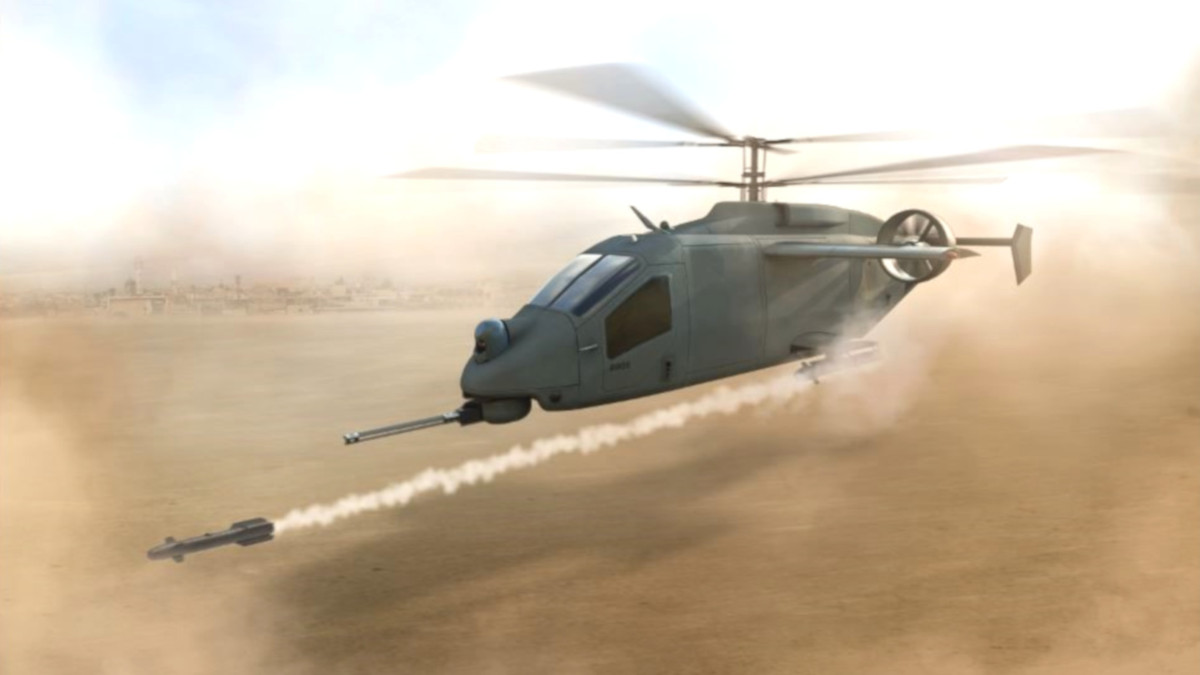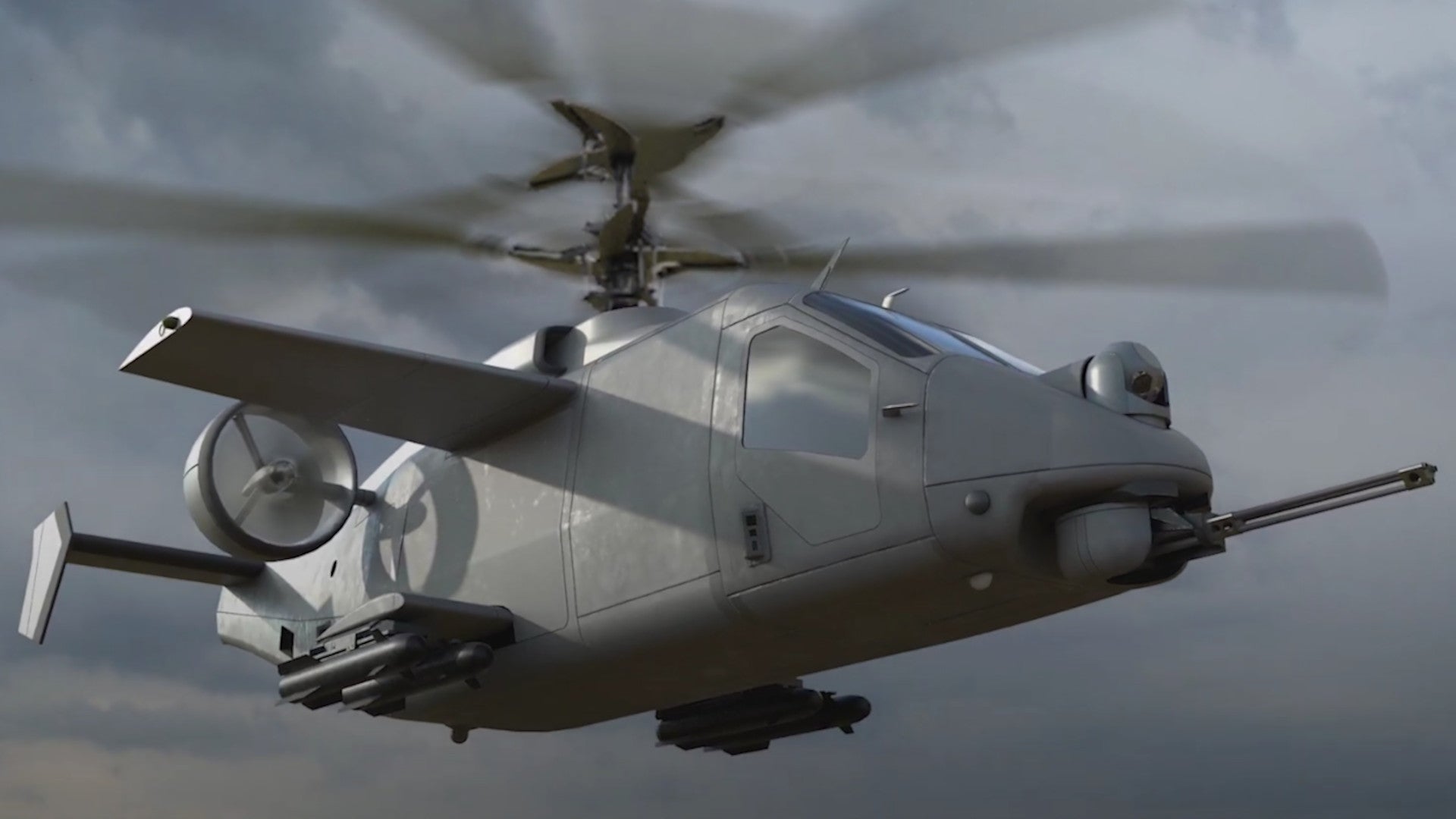AVX Aircraft and L3 Technologies have revealed an advanced compound helicopter design with a coaxial main rotor as their entry for the U.S. Army’s Future Attack Reconnaissance Aircraft program, or FARA. The service wants a high-speed, long-range “knife fighter” that will be a spiritual successor to the OH-58D Kiowa Warrior armed scout helicopter and the winning rotorcraft could replace up to half of the service’s existing AH-64 Apache gunships.
The two companies unveiled their joint entry to coincide with the Army Aviation Association of America’s 2019 Army Aviation Mission Solutions Summit on Apr. 15, 2019. They had previously announced that they had submitted a design together in December 2018. The Army says it will consider between four and six total designs for Phase 1 of the FARA program, before down-selecting two just two competitors in 2020.
“We are extremely pleased to reveal the design for this very important U.S. Army program,” Troy Gaffey, AVX CEO and Chief Engineer, said in a press release. “AVX and L3 provide unique engineering design skills and manufacturing expertise that will provide the Army with an advanced, lethal and affordable reconnaissance and light-attack platform.”
The design the two firms have put forward has obvious similarities to AVX’s previous design work, featuring two ducted fans, one on each side of the upper fuselage, to provide forward thrust, along with a coaxial main rotor. The chopper has small wings near the top of the fuselage, as well as rear stabilizers, too.

The official press release did not include any performance specifics, but the Army has made clear it is looking for the FARA to have better speed and range compared to the AH-64 Apache gunship. The latest AH-64E variant has a top speed of around 170 miles per hour in level flight and a maximum, unrefueled range of around 300 miles. Compound helicopters in general typically offer much greater top speeds over traditional helicopters and the addition of wings can help reduce the load on the rotors, offering added efficiency.
The helicopter also has two separate sub wings on either side of the lower fuselage for stores and the concept art shows it firing a Hellfire-type missile. The Army is looking to steadily replace those weapons with the improved Joint Air-to-Ground Missile (JAGM).
The concept art shows a sensor turret on top of the nose that would include electro-optical and infrared cameras, as well as a laser designator. There is a turret with a multi-barrel Gatling type automatic cannon underneath the nose, as well.
This weapon could be General Dynamics’ new XM915 20mm cannon, which is an evolution of the lightweight three-barrel XM301 it developed in the 1990s for the abortive RAH-66A Comanche stealthy armed scout helicopter. The XM301 was itself a derivative of the iconic six-barrel M61 Vulcan cannon and the earlier three-barrel M197 variant.

The Army is interested in adding loitering munitions, as well as a precision-guided weapon that can function as both a powered missile and a glide bomb, to the FARA’s arsenal, according to Aviation Week. Raytheon’s AGM-176 Griffin, which is already in widespread use in the U.S. special operations community, as well as on small U.S. Navy vessels, could be one option, as it already meets the multi-function criteria. A variety of other miniature air-launched munitions and drones that could work with an aircraft-mounted launcher are also either in service or in development across the U.S. military.
AVX and L3 say the helicopter will have a full fly-by-wire flight control system and features modular, open-architecture avionics and other mission systems to help rapidly incorporate upgrades in the future. This latter feature is one of the Army’s stated requirements for FARA entrants.
The pilot and co-pilot will sit side-by-side in the cockpit, accord to the press release from the two companies. However, the Army has stipulated that any FARA design be able to operate in a pilot-optional mode, as well. Separately, the service is working together with the Defense Advanced Research Projects Agency to develop a “digital co-pilot” that could reduce mental and physical strain on pilots and improve operational effectiveness and safety. You can read more about the Aircrew Labor In-Cockpit Automation System (ALIAS) program here.
The design will also have significant component commonality with the compound helicopters they pitch for the other segments of the service’s broader Future Vertical Lift (FVL) program. This over-arching effort aims to replace all of the Army’s helicopters and could replace various other rotorcraft across the U.S. military. Interestingly, the press release from AVX and L3 says that their design will have folding rotors and wings that will allow it to fit inside a U.S. Air Force C-17 Globemaster III transport plane and within the hangar on an Arleigh Burke-class destroyer, the latter pointing to potential Navy interest in the FARA program.

AVX and L3 have not made any specific mention about features to reduce their helicopter’s radar or infrared signatures, which the Army has also said it will be looking into as part of the FARA program. The service has also stipulated a need for a powerful electronic warfare suite so that whatever FARA design it chooses, in the end, can jam hostile radars for self-protection, as well as locate and destroy those threats to help clear the way for other friendly air assets.
The concept art does show turrets that could be associated with a directional infrared countermeasures (DIRCM) system. These defensive systems, which you can read more about more here, use turreted lasers to blind and confuse the seekers on incoming infrared-homing missiles.
Inclusion in the first phase of the FARA program would be a major development for AVX, which has been promoting its advanced compound helicopter designs since 2005. The company has worked on the Tactically Exploited Reconnaissance Node (TERN) drone as part of a team with Northrop Grumman in the lead. The Defense Advanced Research Projects Agency (DARPA) and the U.S. Navy’s Office of Naval Research are running that program together.
But the Army declined to pursue an offering from the company for the Joint Multi-Role (JMR) fly-off, which is supposed to help inform various Future Vertical Lift requirements. The service picked Bell’s V-280 Valor tilt-rotor and the SB>1 Defiant compound helicopter from Boeing and Sikorsky for this technology demonstration program.
AVX also failed to win the Army’s Armed Aerial Scout (AAS) program, which sought a direct replacement for the OH-58D Kiowa Warrior. The Texas-based helicopter company had offered a novel solution that would have recycled OH-58D main fuselages and converted them into compound helicopters with the company’s characteristic dual ducted fan propulsion arrangement and coaxial rotor system.
The Army ultimately picked a much less significant update offer from Bell, known as the OH-58F, before canceling the AAS program entirely, ostensibly due to budget constraints. In the end, the OH-58D fleet was retired outright. As an interim solution in place of the Kiowa Warriors, the Army established new Heavy Attack Reconnaissance Squadrons with a mix of AH-64 Apaches and RQ-7 Shadow drones. The service had also been working to pair the gunships with the larger MQ-1C Gray Eagle as an alternative combination to fulfill the attack reconnaissance mission.
“The Apache is the best attack helicopter in the world, but it’s not the best armed reconnaissance helicopter,” U.S. Army Brigadier General Walter Rugen, head of the so-called FVL Cross-Functional Team (CFT) within the new Army Futures Command, told Aviation Week earlier in April 2019. “We need a smaller form factor that can hide in the radar clutter and that has reach.”
What this means is that the Army is looking to award a very lucrative deal in the future to potentially replace hundreds of Apaches with the FARA design. The winning bidder will also be well positioned to win contracts to support the operation of those new rotorcraft for decades to come, as well as the development of future upgrades. When it comes to AVX, its decision to partner with L3 was no doubt driven in part by the attraction of leveraging the experience and U.S. military connections of a major established defense contractor with significant experience upgrading and modifying aircraft for the U.S. military.
But this also means that competition will be especially steep. Sikorsky is almost certain to pitch a variant of its S-97 Raider compound helicopter, a design that is already flying and has been in flight testing for years now, making it a front-runner in the competition.

Bell will propose a design, as well, but has been tight-lipped about what it will look like. It seems possible that this will be a derivative of its V-280 tilt-rotor, which is also in flight testing now. The company might also leverage the work it has done on the smaller V-247 Vigiliant tilt-rotor drone.
In addition, Airbus also said it will propose a design derived from its world-record setting high-speed X3 compound helicopter demonstrator. The Army has also already rejected a proposal from MD Helicopters. This became public knowledge after the Government Accountability Office recently disclosed that it had dismissed a protest from that company alleging the Army had acted improperly in arriving at this decision.
With the prospect of losing significant market share with its best customer, Boeing is also working on a compound helicopter derivative of the AH-64 that would offer greatly improved performance. It could potentially submit this as an offering for the FARA competition or pitch it as an outright alternative to an entirely new scout helicopter.
The Army says it expects to make its final decisions about who will get to take part in Phase 1 of the FARA program between June and July 2019. AVX and L3’s entry could be up against significant competition just to get into this first round.
Contact the author: jtrevithickpr@gmail.com
